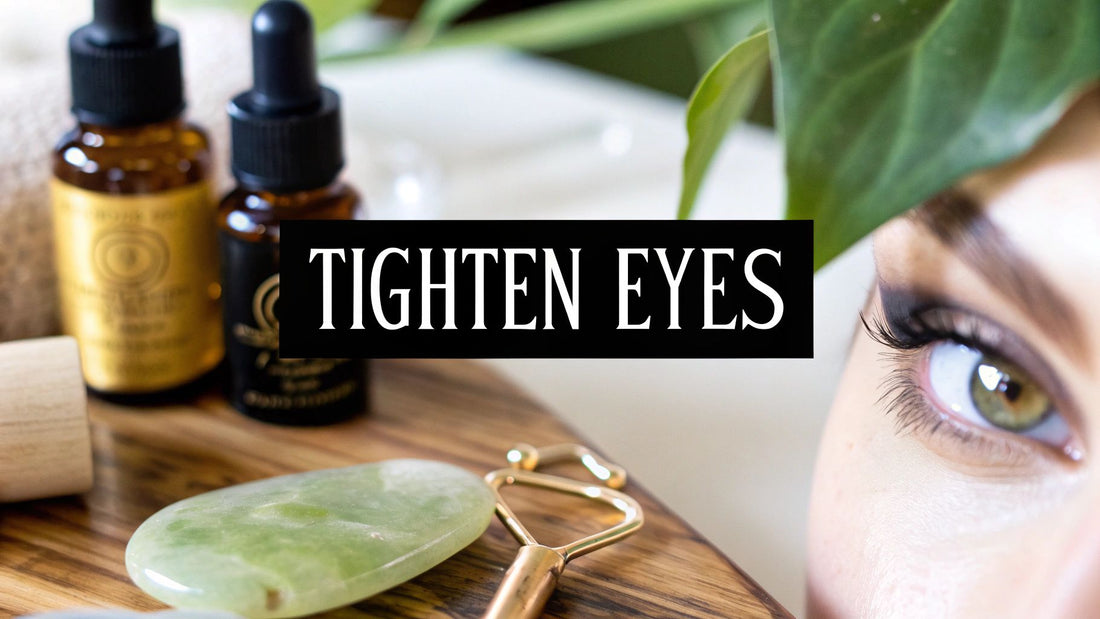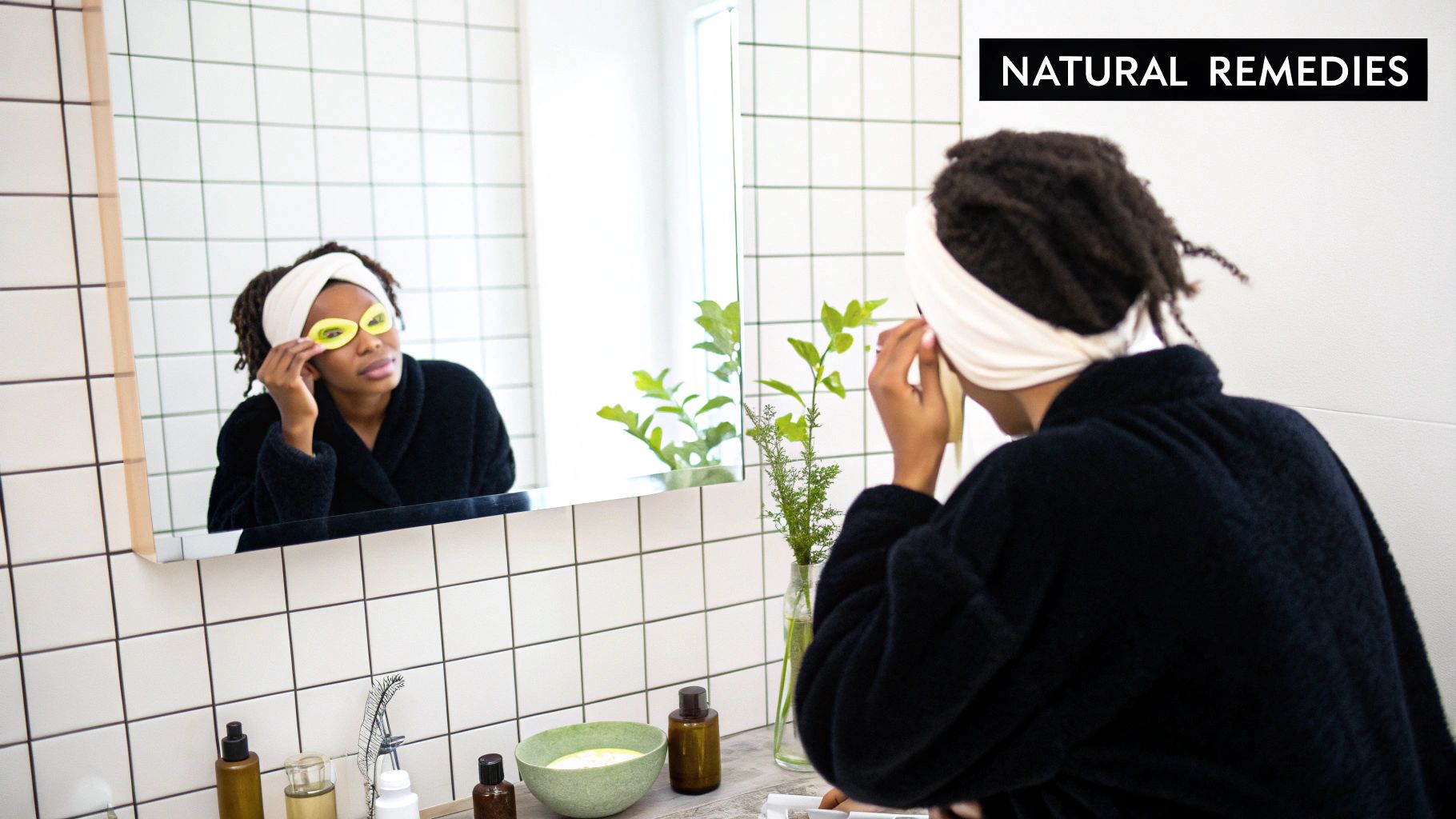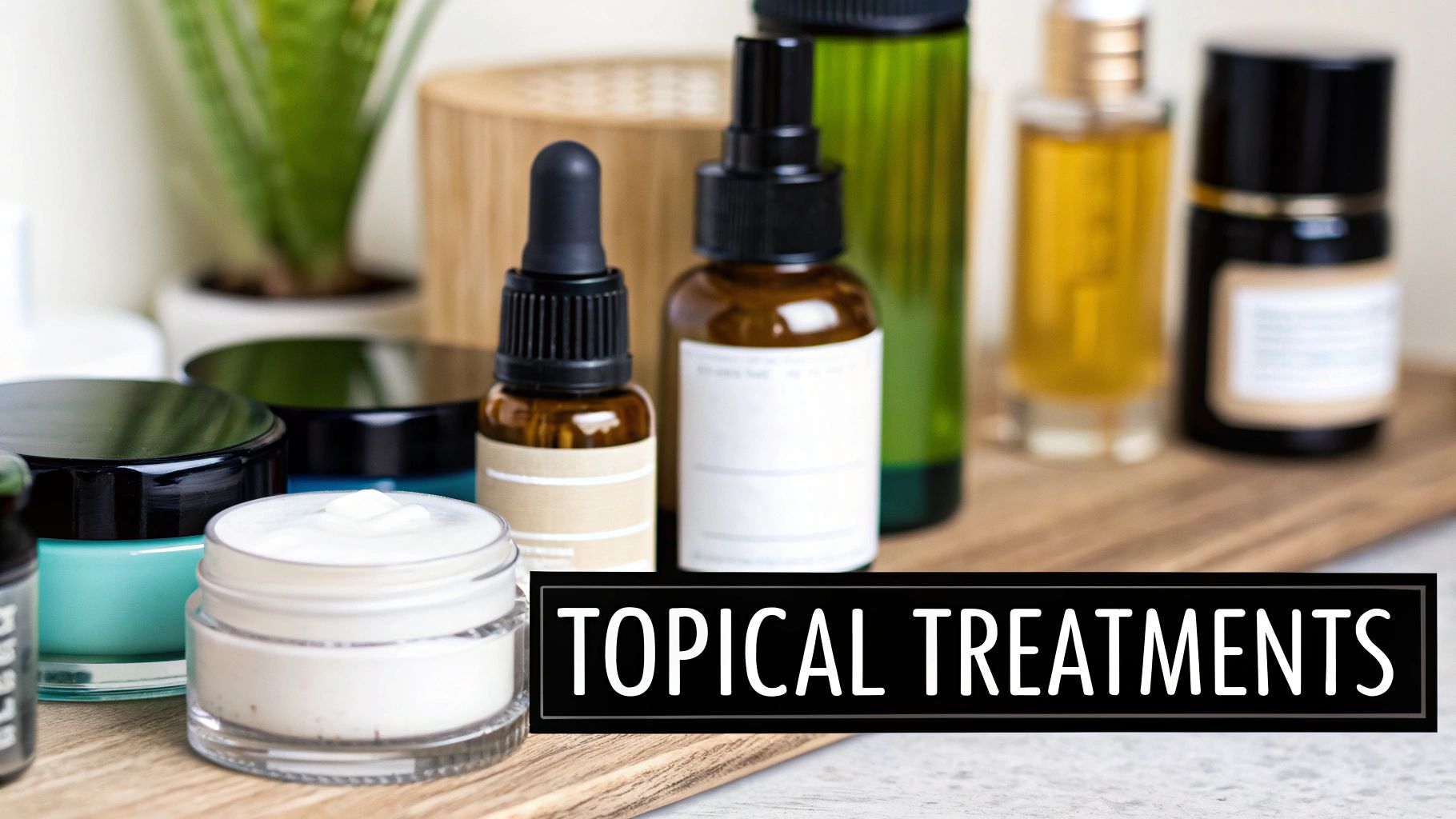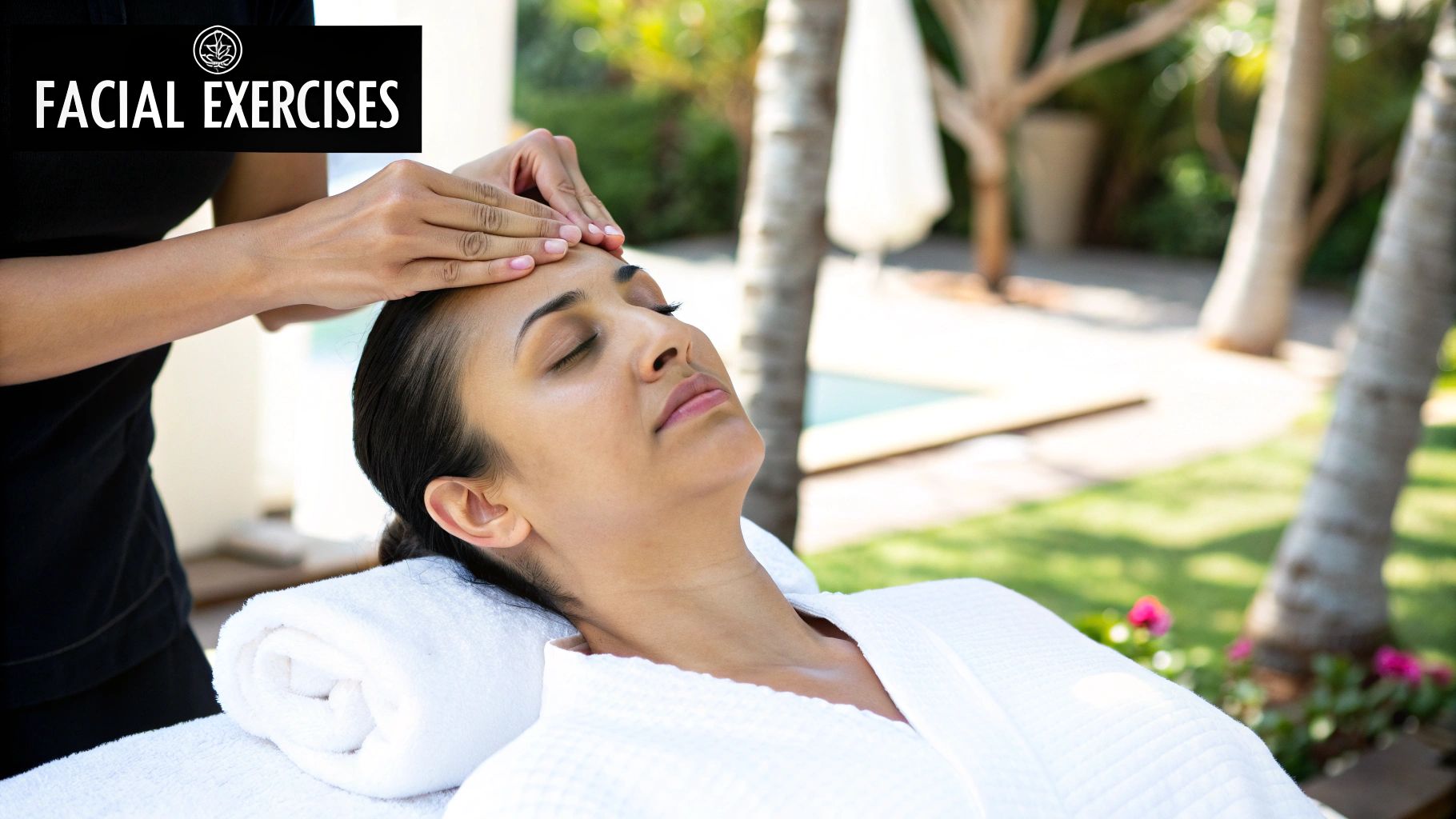
How to Tighten Skin Around Eyes: Tips & Treatments
Share
To get a real handle on how to tighten the skin around your eyes, we first need to look at why it starts to loosen in the first place. It really comes down to a mix of natural ageing, your genetic lottery, and damage from the world around us—especially the sun. Tackling these root causes is where any effective routine begins.
Why Does the Skin Around the Eyes Lose its Firmness?
Have you ever looked in the mirror and thought the skin around your eyes seems to be the first to give the game away? You're not imagining things. The skin in this area is fundamentally different from the rest of your face, which is exactly why it's so quick to show fine lines and lose its bounce.
The skin here is incredibly thin and has very few oil glands. This means less natural moisture and a weaker protective barrier, making it far more prone to dehydration and damage—two major culprits behind sagging and wrinkles. But there's more to the story.
The Unavoidable Duo: Ageing and Genetics
The biggest factor, of course, is simply the passage of time. As we get older, our bodies naturally slow down the production of collagen and elastin. Think of these two proteins as the essential scaffolding that keeps our skin firm, plump, and springy. Research shows that from our early twenties, we lose about 1% of our collagen every single year. This slow, steady decline weakens the skin's structure, and sagging is the inevitable result.
Genetics also has a huge say in the matter. If your parents or grandparents had loose skin around their eyes, chances are you might be predisposed to it too. Your DNA dictates your skin's natural structure and the pace at which it ages.
How Our Environment and Habits Speed Things Up
Beyond our biology, the way we live and the environment we're in can really put the foot on the accelerator. These external factors can hasten the breakdown of that precious collagen and elastin, bringing on the appearance of loose skin much faster.
Some of the main culprits to watch out for are:
- Sun Exposure: This is, without a doubt, the number one cause of premature skin ageing. Even on those classic cloudy UK days, UV rays get through and actively destroy collagen fibres.
- Repetitive Movements: Think about how often you squint, smile, or even just rub your tired eyes. Over time, these constant movements create creases that can eventually settle in as permanent lines.
- Dehydration: If you're not drinking enough water, your skin will show it. Dehydration can leave the under-eye area looking sunken, hollow, and far less plump.
- Lack of Sleep: A string of late nights does more than just make you feel groggy. It stops your skin from carrying out its crucial overnight repair work, which often leads to puffiness and can contribute to long-term sagging.
Getting to grips with these underlying causes is your first real step toward a firmer, more youthful look. It's not just about slapping on a cream to treat the surface; it's about addressing the issues that impact your skin's deep-down health and texture. For a more comprehensive look, you can learn more about how to improve skin texture in our detailed guide.
Building Your Daily Eye Skincare Ritual
Once you've got a handle on the lifestyle factors that affect skin laxity, your most powerful tool is a consistent and well-chosen daily skincare ritual. Committing to a routine packed with proven skin care products is your best defence against loose, crepey skin. This isn’t about random guesswork; it’s about building a practical, effective plan that you’ll actually stick with to see real results over time.
A solid eye care routine is more than just dabbing on a single cream and hoping for the best. It requires a bit of strategy, using different skin care products in the morning versus the evening to protect, repair, and hydrate that delicate skin. The right combination of ingredients works together to help tighten the skin around your eyes and, just as importantly, prevent future damage.
The Powerhouse Ingredients to Look For
Walking down the skincare aisle in the UK can feel overwhelming, but it gets a lot simpler when you know which ingredients actually work. These are the scientifically-backed components you should be looking for on the labels of your eye creams, serums, and other skin care products.
- Retinoids: These are your anti-ageing heavy hitters. As Vitamin A derivatives, they work by speeding up cell turnover and, crucially, kick-starting your skin's own collagen production. More collagen equals firmer, denser skin.
- Peptides: Think of peptides as little messengers. They signal your skin cells to get busy with specific jobs, like building more of the collagen and elastin that provide structure and bounce. They are fantastic for improving overall firmness.
- Hyaluronic Acid: This stuff is a hydration superstar, able to hold up to 1,000 times its weight in water. It plumps the skin from the inside out, which immediately softens the look of fine lines caused by dehydration.
- Antioxidants: Ingredients like Vitamin C, Vitamin E, and green tea are non-negotiable for your morning routine. They act like a shield, protecting the delicate eye area from daily environmental damage from UV rays and pollution.
This image really drives home just how significant those environmental factors are, especially the sun.

The data is pretty stark: sun exposure is blamed for a staggering 80% of skin laxity. That makes daily antioxidant and SPF protection an absolute must for anyone serious about keeping their eye area firm.
To make choosing the right skin care products easier, here's a quick reference table of the most effective ingredients you'll want to find in your eye care treatments.
Key Ingredients for Eye Firming Skincare Products
| Ingredient | Primary Benefit for Eye Area | Best For | Time of Use (AM/PM) |
|---|---|---|---|
| Retinoids | Stimulates collagen, accelerates cell turnover | Fine lines, wrinkles, loss of firmness | PM only |
| Peptides | Signal collagen and elastin production | Sagging, texture improvement | AM and PM |
| Hyaluronic Acid | Deeply hydrates and plumps skin | Dehydration lines, dryness | AM and PM |
| Vitamin C | Fights free radical damage, brightens | Dark circles, sun damage prevention | AM |
| Caffeine | Temporarily constricts blood vessels | Puffiness, under-eye bags | AM |
| Niacinamide | Strengthens skin barrier, brightens | Sensitivity, dark circles | AM and PM |
Using this table can help you quickly scan ingredient lists and decide if a product has what you need for your specific concerns, whether that's tackling puffiness in the morning or deep-set lines at night.
Your Morning vs Evening Routine
Your skin has different needs from sunrise to sunset, so your routine should reflect that. A split approach means you’re giving your skin protection when it's most vulnerable and focusing on repair while you rest.
In the morning, your goal is protection. After cleansing, apply an antioxidant-rich eye serum or cream. I always recommend one with Vitamin C to help fight off those environmental aggressors you encounter all day. An eye cream with SPF is also an excellent choice for added defence.
Your evening routine, on the other hand, is all about repair and rejuvenation. This is the perfect time to bring out the more potent, active ingredients like retinoids or peptides. These ingredients work their magic best overnight, supporting the skin's natural repair cycle without having to contend with sun exposure.
A quick expert tip: How you apply your eye cream really does matter. Always use your ring finger, as it has the lightest touch. Gently tap the product along the orbital bone—that's the bone you can feel around your eye socket—moving from the inner corner outwards. Never pull or drag the skin.
Layering your skin care products correctly is also vital. To get the most out of your eye cream, apply it after cleansing and toning but before your heavier facial moisturiser and sunscreen. This gives its specialised ingredients a clear path to penetrate the skin. Consistency is everything, and integrating these small steps into a wider regimen is what makes the difference. For more guidance on piecing it all together, have a look at our advice on building the ultimate skincare routine for radiant healthy skin. By dedicating just a minute each morning and night, you create a powerful ritual that supports long-term skin health and firmness.
Lifestyle Habits That Support Firmer Skin

While a great eye cream is a powerful tool in your arsenal, the truth is, what you do every day often matters more. To really get a handle on tightening the skin around your eyes, you need to combine your skincare routine with habits that build healthy skin from the inside out.
Think of it this way: your lifestyle lays the foundation. Without solid groundwork, even the most expensive skin care products can only do so much. These daily habits directly impact how well your skin produces collagen, stays hydrated, and repairs itself, making your skincare far more effective.
Fuel Your Skin with a Nutrient-Rich Diet
You’ve heard the saying "you are what you eat," and I’ve seen first-hand just how true this is for skin. To encourage firmness and resilience, your diet needs to be loaded with antioxidants and healthy fats. These are the very things that protect your skin's structure and help rebuild it.
Antioxidants are your personal bodyguards against the damage from UV rays and pollution—two of the biggest culprits in collagen breakdown. By filling your plate with colourful fruits and vegetables, you’re essentially arming your skin to defend itself.
A good place to start is by adding these to your shopping list:
- Berries and Citrus Fruits: They are bursting with Vitamin C, which isn't just good for colds; it's absolutely essential for your body to actually synthesise new collagen.
- Leafy Greens: Think spinach and kale. They're packed with a cocktail of vitamins and antioxidants that your skin loves.
- Healthy Fats: Foods like avocados, nuts, and oily fish (like salmon) provide omega-3 fatty acids. These help keep your skin cell membranes strong and supple, which translates to a plumper, smoother look.
This isn’t about a restrictive diet. It’s about consistently giving your body the raw materials it needs for firm, healthy skin.
A study I often reference showed that diets high in Vitamin C were directly linked to a better skin-ageing appearance. It’s a great reminder that something as simple as adding an orange to your breakfast can make a genuine difference over time.
The Critical Role of Hydration
Let's be clear: proper hydration is non-negotiable for firm skin. When you're dehydrated, that delicate skin under your eyes is one of the first places it shows. It can quickly look sunken, thin, and crepey.
Drinking enough water throughout the day is key to maintaining your skin’s elasticity and fullness. It works hand-in-hand with hydrating skin care products like those containing hyaluronic acid, helping them do their job properly. A good rule of thumb is to aim for about eight glasses of water a day, but listen to your body—you might need more depending on your activity levels.
If you find plain water a bit boring, try infusing it with cucumber and mint, or switch to herbal teas. Every sip helps.
Make Sleep and Sun Protection Your Top Priorities
Night-time is when the magic happens. Your skin goes into full repair mode while you sleep, increasing blood flow and rebuilding the collagen and elastin fibres that keep it firm. Consistently skimping on sleep cuts this vital process short, which can lead to puffiness and accelerate sagging.
At the same time, protecting your eyes from the sun is probably the single most impactful thing you can do. UV radiation is the number one cause of premature ageing because it directly destroys collagen.
Here are a few non-negotiable daily habits:
- Wear Sunglasses: Make sure they offer 100% UV protection. This isn't just about shielding the skin; it also stops you from squinting, a repetitive movement that carves lines around the eyes over time.
- Prioritise Quality Sleep: Getting 7-9 hours of good-quality sleep is the goal. This gives your skin the full window it needs to regenerate and undo some of the day's damage.
- Avoid Smoking: Smoking is disastrous for the skin. It constricts blood vessels, starving your skin of the oxygen and nutrients it needs to thrive. It also unleashes free radicals that wage war on your collagen and elastin. If you're a smoker, quitting is one of the best things you can do for your skin.
At-Home Tools and Massage for a Natural Lift

Beyond the creams and serums you use every day, a more hands-on approach can make a real difference. Targeted massage and the right at-home tools can seriously boost your efforts to tighten the skin around your eyes. It all comes down to improving circulation, getting the lymphatic system moving, and easing the muscle tension that builds up around our eyes.
Think of it as a gentle workout for your face. These techniques won't give you the overnight results of a clinic treatment, but they are a brilliant, low-cost way to enhance your daily skin care products and see a noticeable, natural lift over time.
Mastering Facial Massage and Lymphatic Drainage
Sometimes, the most powerful tool is one you already have: your hands. With a bit of good quality eye cream or facial oil for slip, you can gently encourage the fluid that causes puffiness to move away from the eye area. It’s surprisingly effective.
A simple technique I always come back to involves using my ring finger—it has the lightest touch. I start at the inner corner under my eye and just slowly sweep outwards towards the temples. Repeating this a few times is a fantastic way to start the morning, as it really helps shift that stagnant fluid and reduce puffiness.
For a slightly more involved massage, try this:
- Warm up the area: Gently tap around your orbital bone (the bone surrounding your eye socket) for about 30 seconds. This gets the blood flowing.
- Sweep it out: With your ring finger, sweep from the inner corner, up towards your temple, and then continue down the side of your face to help drain the fluid away.
- Ease the brow: Gently pinch along your brow bone, moving from the inside to the outside. This is wonderful for releasing the tension that can make your eyes look heavy and tired.
This isn't just about moving fluid. It's about boosting circulation. When you improve blood flow, you're delivering more oxygen and nutrients to the skin cells. This not only supports their health but also helps all those expensive skin care products absorb and work much better.
Navigating At-Home Skincare Tools
The UK beauty market is full of at-home devices promising to tighten skin around the eyes. It's easy to get drawn in, but I always advise clients to have realistic expectations about what they can achieve.
-
Gua Sha and Jade Rollers: These are fantastic manual tools for massage. I particularly love them for promoting lymphatic drainage. Keep them in the fridge, and the cooling effect is a godsend for tackling morning puffiness. Always use them with a facial oil, gliding the tool gently from the centre of your face outwards. If you're consistent, using one 3-4 times a week can really help depuff and subtly sculpt the area.
-
Microcurrent Devices: These gadgets send tiny, completely painless electrical currents into the skin. The idea is to stimulate your facial muscles and encourage collagen production—it's often called a "workout for your face." The results are temporary and you have to be committed, using it at least 5 times a week to begin with, but over time, they can certainly create a more lifted and toned appearance.
Whatever tool you choose, the secret is consistency and using it correctly. Always be gentle; never pull or drag at that delicate skin. While these methods won't erase deep wrinkles or significant sagging, they are a powerful partner in keeping the eye area looking firm, refreshed, and healthy.
Exploring Professional Non-Surgical Treatments

When your at-home routine and daily skin care products just aren't cutting it anymore, it might be time to look into professional treatments. For those of us seeking a more noticeable lift without going under the knife, these non-surgical options are a brilliant middle ground. They offer a powerful way to get visible, skin-tightening results without the recovery time or commitment of surgery.
A good aesthetician will have a whole toolkit of technologies designed to tackle the root causes of loose skin. These treatments work in a fascinating way: they create tiny, controlled "injuries" deep within the skin. This clever trick kick-starts your body's natural healing response, triggering a surge of fresh collagen and elastin—the very proteins that keep your skin firm and bouncy. Over time, the result is smoother, stronger skin around your eyes.
Radiofrequency Treatments
Radiofrequency, or RF, is a real star player when it comes to firming up the delicate eye area. It uses energy waves to gently warm the deeper layers of your skin. This warmth has a two-fold effect: it causes your existing collagen fibres to contract for an immediate tightening feeling, and it signals your skin to start building new collagen for long-term improvement.
The treatment itself is quite comfortable. A handheld device glides over the skin, and most people just feel a pleasant warmth. Best of all, there’s usually no downtime, so you can genuinely pop in on your lunch break. While you might see a difference after just one session, a course of treatments is usually what’s needed for lasting, impressive results.
The shift towards these less invasive options is clear. In the UK, non-surgical facial procedures are more popular than ever. Take FaceTite, for example, which also uses radiofrequency to firm up the brows and jowls. It has been a consistently popular treatment, with hundreds of procedures performed each year since 2020. It just goes to show how many of us prefer effective skin-tightening methods that don't involve surgery.
Microneedling and Laser Resurfacing
Two other fantastic options you’ll likely come across are microneedling and laser resurfacing. Both are masters at rejuvenating tired skin.
-
Microneedling: Often called collagen induction therapy, this procedure involves using a device with tiny, sterile needles to create micro-punctures in the skin. Don't worry, it sounds scarier than it is! Your skin's natural response is to rush to heal these tiny channels, flooding the area with growth factors that build strong, new collagen. It’s brilliant for improving skin texture and softening fine lines.
-
Laser Resurfacing: This works by using focused beams of light. Some lasers (ablative) remove the outermost layer of skin, while others (non-ablative) simply heat the underlying tissues. Either way, the process encourages fresh, healthy skin to grow in its place and gives collagen production a massive boost, effectively tightening the skin.
A consultation with a qualified professional is non-negotiable. They're the experts who can properly assess your skin, listen to what you want to achieve, and recommend the treatment that’s truly right for you. This ensures your journey to firmer skin is both safe and effective.
While these treatments are fantastic for tackling deeper laxity, they work even better on well-cared-for skin. To complement your professional treatments, take a look at our guide on how to reduce fine lines for tips on managing those surface-level concerns.
When to Consider a Surgical Solution Like Blepharoplasty
There comes a point where even the most dedicated skincare regimen and sophisticated non-surgical treatments can’t quite deliver the results we’re after. When the skin on the upper eyelids becomes so loose that it droops over the lash line, creating what many call ‘hooded eyes’, or when stubborn bags take up permanent residence under your eyes, it might be time to think about a surgical option.
For these more significant concerns, blepharoplasty, commonly known as eyelid surgery, stands out as the most effective and durable solution. This procedure is tailored to remove excess, sagging skin and, when needed, reposition or remove fat deposits from either the upper or lower eyelids. It gets right to the heart of the structural problems that even the best skin care products and non-invasive treatments simply can't resolve.
Who Is a Good Candidate for Eyelid Surgery?
Making the decision to have surgery is a big one. It's usually best reserved for people whose loose eyelid skin is causing genuine functional problems or is a major cosmetic concern.
You might find yourself considering this path if you:
- Have drooping upper eyelids that are starting to interfere with your field of vision, making things like reading or driving a challenge.
- Feel that heavy, hooded lids or prominent under-eye bags make you look constantly tired or older than you feel.
- Have already explored non-surgical avenues but haven't seen the level of improvement you were hoping for.
In the UK, traditional surgical procedures like blepharoplasty are still a go-to treatment for tightening the skin around the eyes, particularly for hooded lids and significant sagging. In fact, eyelid surgery is the fourth most common plastic surgery in the UK, with over 209,000 procedures performed each year. You can delve into these trends and what they mean for patients looking for lasting eye rejuvenation results in the UK.
While the recovery is certainly longer than for non-surgical treatments, the results are undeniably more dramatic and permanent. When significant skin laxity is the main issue, blepharoplasty is widely seen as the gold standard for achieving a more alert, refreshed, and youthful appearance around the eyes.
The crucial next step is a thorough consultation with a board-certified oculoplastic or facial plastic surgeon. They will be able to properly assess your individual anatomy, listen to your goals, and walk you through all the available options so you can make a truly informed decision.
At P-Eleven, we believe in empowering you with knowledge for every step of your skincare journey. For daily maintenance and enhancing your skin’s resilience, explore our collection of science-backed, natural skin care products designed to support a firm and radiant complexion. Visit us at https://p-eleven.com to discover your ideal routine.


